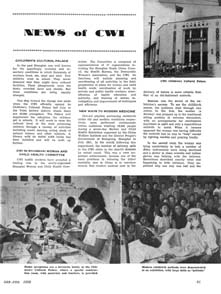CHILDREN'S CULTURAL PALACE
In the past Shanghai was well known for the appallingly crowded and insanitary conditions in which thousands of workers lived, ate, slept and died. Few children went to school. They never dreamed that they might have cultural facilities. Their playgrounds were the dusty, crowded lanes and streets. But these conditions are being rapidly changed.
One step toward the change was made when the CWI officially opened its Children's Cultural Palace last July in the Yulin factory district, where there are 40,000 youngsters. The Palace will supplement the education the children get in schools. It will work to raise the cultural level of the most promising children through a variety of activities including music, dancing, acting, study of natural history and other subjects. A library with an initial 4,000 books has been installed and will be built up further.
CWI IN SHANGHAI WOMAN AND CHILD HEALTH COMMITTEE
CWI health workers have accepted a leading role in the newly-organized Shanghai Woman and Child Health Committee. The Committee is composed of representatives of 17 organizations including the Shanghai Trade Union Council, the Health Bureau, the Democratic Women's Association, and the CWI. Its functions will include planning and coordinating of all activities in the field; preparation of plans for woman and child health work; coordination of work by private and public health workers; intensification of health education and publicity, and training of cadres; investigation and improvement of techniques and efficiency.
NEW WAYS TO MODERN MEDICINE
One-act playlets portraying childbirth under old and modern conditions respectively were performed continuously before audiences totalling 16,000 people during a seven-day Mother and Child Health Exhibition organized by the China Welfare Institute and the District People's Government of Kiangning, Shanghai in July 1951, In the month following this experiment, the number of delivery calls to the CWI clinic in the district doubled by actual count. This was a very important achievement, because one of the main problems in reducing the infant mortality rate in China is to convince women that modern medical care in the delivery of babies is more reliable than that of an old-fashioned midwife.
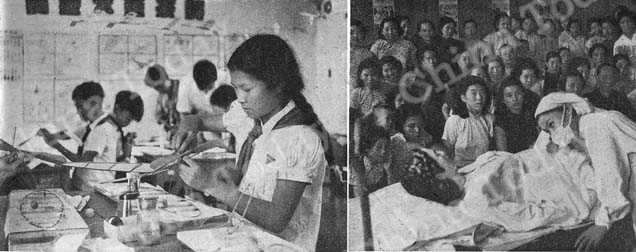
Model aeroplanes are a favourite hobby at the Children's Cultural Palace, where a special construction room, with materials and teachers, is provided. Modern childbirth methods were demonstrated at an exhibition, with large dolls as "patients."
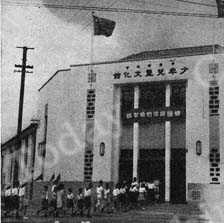
CWI Children's Cultural Palace.
Realism was the secret of the exhibition's success. To see the childbirth scenes, the audience filed through two rooms. In the first, the mother (a dummy) was propped up in the traditional sitting position in extreme discomfort, with no arrangements for sterilization anywhere in sight and only a superstitious midwife to assist. When it became apparent the woman was having difficulty the midwife had no way to "help" except by lighting candles and praying loudly.
In the second room the woman was lying comfortably in bed, a number of shiny instruments were being sterilized and a doctor in clean overalls and rubber gloves was helping with the delivery. Raconteurs described exactly what was happening in both tableaux. They explained why one way was bad and the other good, and what consequences might be expected from each.
Other sections of the exhibition showed how to provide cheap, nutritious meals for children and how best to clothe and care for them so that they might be healthy and strong.
In a room devoted to diet, the comparative food values of easily obtained foods such as cabbage, beans and soybean milk, were explained and demonstrated. The whole approach was different from that too often adopted in previous "show window" exhibits which blandly advised people to eat plenty of oranges, vitamin pills and other things that they could not possibly afford.
Also included in the exhibition were a nursery and a hospital room. The nursery emphasized cleanliness and the importance of frequent changes of clothes for children. It also showed the best types of toys and illustrated model seven-day diets for children from two to five years old.
A one-act play in the hospital room showed a father bringing in his sick child, a diagnosis of diphtheria, the treatment given the child when left in the hospital, and its final return home after recovery. The play aimed at breaking down people's fears of hospitalizing their children.
The impression created by the exhibition was reflected in the following comments in the visitors' book.
"After seeing the exhibition, we changed our minds about having our babies delivered by old-fashioned midwives."
- Two pregnant workers of China Sun Dyeing Factory
"After seeing the exhibition, 1 feel that women workers urgently need this kind of practical education. It greatly increases the knowledge of woman and child health. 1 also feel that it demonstrates that the People's Government is truly thinking of the benefit of the people and the happiness of the next generation."
- Hsu Ching, Wing On Textile Mill No. 3.
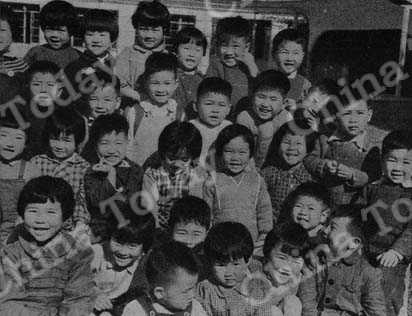
Kiddies in a CWI nursery.
SOVIET EXPERT VISITS NURSERY
The CWI Nursery in Shanghai, which cares for 190 children from two to five years old, received a visit from an experienced Soviet woman and child health worker, Dr. Tzibulskaya on May 30, 1951. After examining the children, buildings and equipment, the doctor asked many questions concerning the diet, daily schedule and general operation.
In a discussion with staff members afterwards, Dr. Tzibulskaya expressed her approval of what was being done and gave some practical advice. She recommended that every possible use should be made of sunshine and fresh air to build up the resistance of the children and make them grow healthy and strong. She thought it was a mistake to let them rest in rooms with curtained windows but that they should be accustomed to sleep in broad daylight. Generally, she emphasized that they should not be coddled.
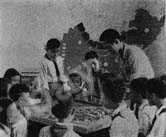
Geography Class.
Dr. Tzibulskaya also suggested that different schedules be worked out for the varying age groups, and that aril laundry be both boiled and ironed for full sterilization.
SUMMER COURSE
One hundred and six boys and girls aged from 11 to 15, members of the Pioneer organizations of schools in the Yulin factory district of Shanghai, attended a one-month summer vacation course organized by the CWI Children's Cultural Palace and the Yulin Young Pioneers. The aim of the course was to raise the cultural level of the most promising school children in the workers' area and to develop their sense of responsibility and leadership.
The boys and girls were housed in one of the Yulin primary schools. They were given the run of the newly-opened Children's Cultural Palace for their studies and activities which included art, music, dancing, literature, geography and model airplane construction. A nearby textile factory gave them the use of its swimming pool. Much time was spent on physical culture and sports and no child gained less than two pounds in weight during the month.
The biggest event for the children most of whom had never been outside Shanghai, was a two-day excursion to the sea-coast where they visited the navy, had a long discussion with a famous model woman agricultural worker, and insisted on getting up at three in the morning to see the sun rise over the sea.
In drawings, art work and discussions the children expressed the new happiness that had come into their lives since the formation of the People's Government and the sure hopes they had for the future.
ORGANIZATIONS TAKEN OVER
In Shanghai, the Chapei and Hongkew Child Welfare Centres and a day nursery formerly subsidized by the U.S. Church World Service were taken over by the China Welfare Institute last August.
The two welfare centres, housed in quonset huts, are being reorganized as children's libraries and reading rooms. The nursery, which has been caring for forty infants from two to five years old, will be continued for the time being with the same staff as before.


 Copy Reference
Copy Reference 